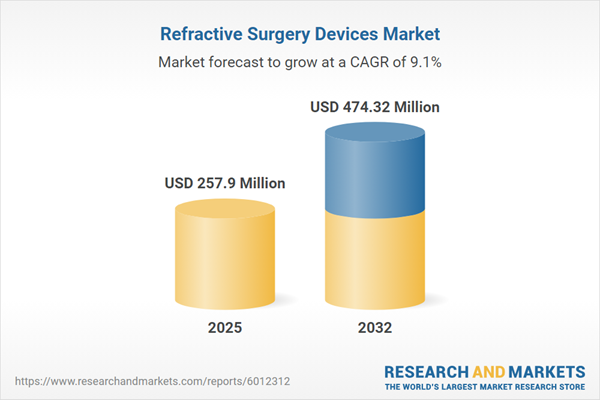Speak directly to the analyst to clarify any post sales queries you may have.
The refractive surgery devices market is experiencing rapid transformation, shaped by advancements in laser technologies, evolving patient preferences, and realignment of supply chains. Senior decision-makers face an environment of ongoing innovation and operational complexity, requiring clear insights for strategic planning in this sector.
Market Snapshot: Refractive Surgery Devices Market Size and Growth
The refractive surgery devices market grew from USD 236.13 million in 2024 to USD 257.90 million in 2025. It is expected to maintain a CAGR of 9.11%, reaching USD 474.32 million by 2032. This trajectory is driven by technology convergence, shifting patient demographics, and increasing demand for advanced vision correction procedures.
Scope & Segmentation
- Product Types: Excimer Laser Systems, Femtosecond Laser Systems, Phakic IOLs (Angle Supported, Iris Claw, Posterior Chamber)
- Technologies: LASEK, LASIK, PRK, SMILE
- Applications: Astigmatism Correction, Hyperopia Correction, Myopia Correction, Presbyopia Correction
- End Users: Ambulatory Surgical Centers, Hospitals, Ophthalmic Clinics
- Distribution Channels: Direct Sales, Distributor Sales
- Regional Coverage: Americas (United States, Canada, Mexico, Brazil, Argentina, Chile, Colombia, Peru), Europe, Middle East & Africa (United Kingdom, Germany, France, Russia, Italy, Spain, Netherlands, Sweden, Poland, Switzerland, United Arab Emirates, Saudi Arabia, Qatar, Turkey, Israel, South Africa, Nigeria, Egypt, Kenya), Asia-Pacific (China, India, Japan, Australia, South Korea, Indonesia, Thailand, Malaysia, Singapore, Taiwan)
- Main Companies Profiled: Alcon Inc., Johnson & Johnson Surgical Vision, Inc., Bausch + Lomb Incorporated, Carl Zeiss Meditec AG, Nidek Co., Ltd., Lumenis Ltd., Ziemer Ophthalmic Systems AG, SCHWIND eye-tech-solutions GmbH & Co. KG, Iridex Corporation, Rayner Intraocular Lenses Limited
Key Takeaways for Senior Decision-Makers
- Technological advancements in laser beam modulation and intraocular lens design are broadening the range of correction techniques available to clinics.
- Emerging diagnostic solutions strengthen clinical workflows by providing actionable, data-driven insights, enhancing surgeon and patient confidence.
- Regulatory evolutions, particularly streamlined approvals, encourage prompt device launches and competitive market entry across multiple regions.
- Integrated training and digital health platforms are central to maximizing utilization rates and supporting consistent patient outcomes across diverse geographies.
- Strategic alliances and partnerships accelerate innovation in refractive surgery, improving both operational continuity and product portfolios.
Tariff Impact: Strategic Responses to the 2025 U.S. Import Duties
In 2025, new U.S. import tariffs on advanced laser systems and intraocular lens components are pressuring manufacturers and providers to overhaul sourcing strategies. Companies are prioritizing nearshoring and diversifying supplier networks to stabilize pricing and minimize disruptions. This industry shift has prompted expanded local assembly, increased workforce training, and new procurement models to maintain operational flexibility. Some segments also benefit from domestic incentives supporting technology production and adoption, underscoring the need for ongoing supply chain vigilance and agile risk management.
Methodology & Data Sources
This report combines in-depth primary interviews with ophthalmic professionals and procurement leaders with a thorough review of peer research, government filings, and technology literature. Patent analysis and corporate disclosures supplement findings. All data underwent triangulation and quality checks to ensure factual accuracy across segments and regions.
Why This Report Matters
- Enables informed investment, procurement, or partnership decisions in a rapidly evolving sector driven by technology and operational change.
- Offers actionable segmentation across product types, applications, regions, and principal market players for tailored strategy development.
- Supports risk mitigation by clarifying the potential impacts of regulatory changes and supply chain shifts.
Conclusion
Strategic alignment in the refractive surgery devices market demands attention to innovation, regulatory adaptation, and supply chain agility. Organizations positioned to leverage cross-disciplinary partnerships and adopt modular, data-driven approaches will capture emerging growth opportunities in this dynamic landscape.
Additional Product Information:
- Purchase of this report includes 1 year online access with quarterly updates.
- This report can be updated on request. Please contact our Customer Experience team using the Ask a Question widget on our website.
Table of Contents
3. Executive Summary
4. Market Overview
7. Cumulative Impact of Artificial Intelligence 2025
List of Figures
Samples

LOADING...
Companies Mentioned
The key companies profiled in this Refractive Surgery Devices market report include:- Alcon Inc.
- Johnson & Johnson Surgical Vision, Inc.
- Bausch + Lomb Incorporated
- Carl Zeiss Meditec AG
- Nidek Co., Ltd.
- Lumenis Ltd.
- Ziemer Ophthalmic Systems AG
- SCHWIND eye-tech-solutions GmbH & Co. KG
- Iridex Corporation
- Rayner Intraocular Lenses Limited
Table Information
| Report Attribute | Details |
|---|---|
| No. of Pages | 189 |
| Published | October 2025 |
| Forecast Period | 2025 - 2032 |
| Estimated Market Value ( USD | $ 257.9 Million |
| Forecasted Market Value ( USD | $ 474.32 Million |
| Compound Annual Growth Rate | 9.1% |
| Regions Covered | Global |
| No. of Companies Mentioned | 11 |









